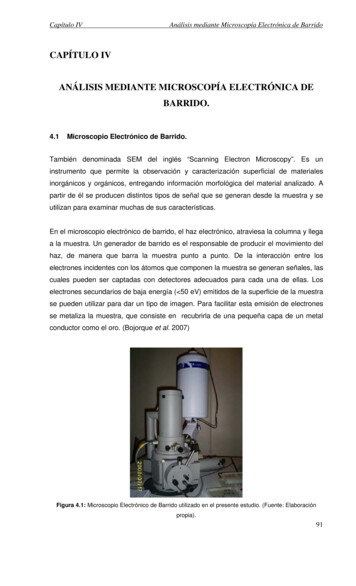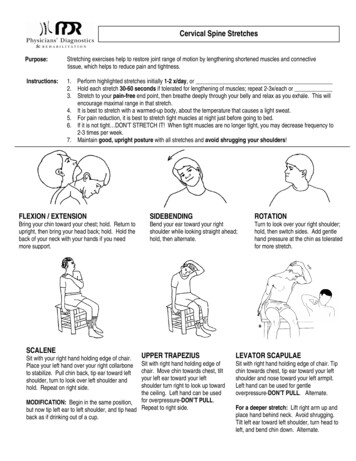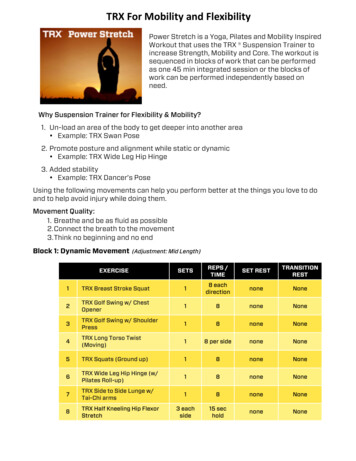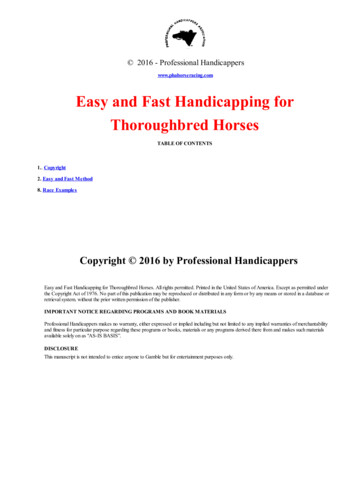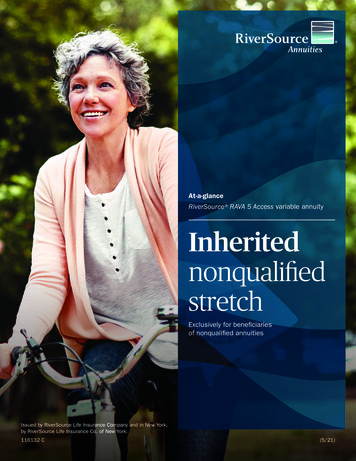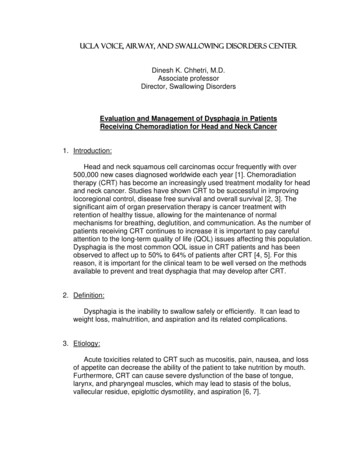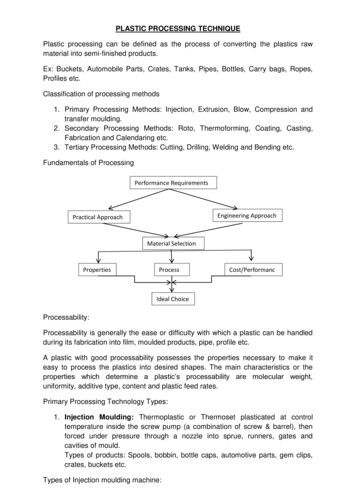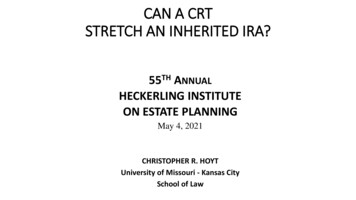
Transcription
CAN A CRTSTRETCH AN INHERITED IRA?55TH ANNUALHECKERLING INSTITUTEON ESTATE PLANNINGMay 4, 2021CHRISTOPHER R. HOYTUniversity of Missouri - Kansas CitySchool of Law
Stretch IRA “Stretch IRA” means an inherited retirement account(e.g., IRA), where payments are gradually made overthe beneficiary’s life expectancy Until the enactment of the SECURE Act, it was fairlyeasy for any beneficiary who inherited a retirementaccount to receive distributions until the age of 83(or older for beneficiaries who inherited at an older age) Beginning 2020: General rule is a ten year liquidation Can a CRT get lifetime payout comparable to stretch?
CAN A CRTSTRETCH AN INHERITED IRA? Required distributions from retirement accounts Overview of charitable remainder trusts Situations that produce the best results for family Combination of a long-term CRT (between 30 and 55years) and high income tax rates on IRD Obstacles and solutions 10% charitable deduction with young beneficiaries Term-of-years CRT won’t get much deferral Problem when federal estate tax was paid
REQUIRED MINIMUM DISTRIBUTIONS LIFETIME RMDs from your own account RMDs from an inherited accountFailure to receive that year’s RMD triggers a 50% excisetax on the shortfall that wasn’t distributed. §4974
REQUIRED MINIMUM DISTRIBUTIONS*LIFETIME DISTRIBUTIONS*TWO CHANGES FOR LIFETIME RMDs:1. New RMD Age : 72(for people who attain age 70 ½ after 2019)(Despite new age 72, charitable QCD still 70 ½)2. New life expectancy tables (beginning in 2021)Annual RMD amounts will decline bybetween 0.3% and 0.5% each year (varies by age)
REQUIRED MINIMUM DISTRIBUTIONS*LIFETIME DISTRIBUTIONS – YEAR 2021Age of Account Owner Required 3%15.88%
REQUIRED MINIMUM DISTRIBUTIONS*LIFETIME DISTRIBUTIONS – YEAR 2022Age of Account Owner Required 4%15.71%
Distributions from Inherited RetirementAccounts Are Taxable IncomeIncome In Respect of A Decedent “IRD” –§691 No stepped up basis for retirement assets Distributions from inherited retirement accounts areusually taxable income to the beneficiaries.
USUAL OBJECTIVE:Defer paying income taxesin order to get greater cash flow Pre-Tax AmountPrincipal10% Yield 100,000 10,000 Income Taxon Distribution (40%) Amount Left to Invest40,000 60,000 6,000
Stretch IRA “Stretch IRA” means an inherited retirementaccount (e.g., IRA), where payments aregradually made over the beneficiary’s lifeexpectancy Until the enactment of the SECURE Act, it wasfairly easy for any beneficiary who inherited aretirement account to receive distributions untilthe age of 83 (or older for beneficiaries whoinherited at an older age) New rules apply beginning in year 2020
Distributions After Death(for decedents who die in 2020 and later)Maximum time period to empty account: Ten years (No RMD until year #10)[the account needs to be empty by December 31of the tenth year after the year of the decedent’death, or else there is a 50% penalty on thebalance]
RETIREMENT PLANS SUBJECT TO THE LAW Section 401(a) - Employer pension, profit sharing and stockbonus plans[incl. 401(k)] Section 408 – IRAs Section 403(b) - School and charity employers Section 457(b) plans - Government and tax-exempt employers
DistributionsAfter DeathCompany policy may require faster liquidation Employer might require account ofdeceased employee to liquidated in justone year No such problem with IRAs Beneficiary of employer plan account cancompel transfer to an inherited IRA
Distributions After Death(for decedents who die in 2020 and later)Maximum time period to empty account: Ten years (No RMD until year #10), or Remaining life expectancy of an “eligibledesignated beneficiary” (RMD every year)-- surviving spouse -- minor child of the decedent-- disabled individual -- chronically ill person-- beneficiary within 10 years of age of decedent
MARRIED COUPLES:RETIREMENT ASSETSSurviving spouse has an option that noother beneficiary has:a rollover of deceased spouse’s retirement assets toher or his own new IRA(creditor protection, too!)Other beneficiaries cannot do a rollover.Main option: liquidate over ten years
LEAVE IN DECEASED SPOUSES’ ACCOUNT? Generally, a rollover produces greater income tax deferral thanleaving assets in the decedent’s account Two situations when it may be advisable to leave some assetsin the decedent’s account (at least for a while) Surviving spouse is under age 59 ½ Deceased spouse was under age 72, and surviving spouse ispast that age (e.g., deceased was age 68 and survivor is age 74)
LEAVE ASSETS IN DECEDENT’S ACCOUNT?Required Distributions if theSurviving Spouse is the Sole Beneficiary Spouse can recalculate life expectancy IRAs only: Spouse can elect to treat IRA as her own Decedent died before age 72 ? No required distribution until year the deceased spousewould have been age 72
Distributions After Death(for decedents who die in 2020 and later)Maximum time period to empty account: Ten years (No RMD until year #10), or Remaining life expectancy of an “eligibledesignated beneficiary” (RMD every year)-- surviving spouse -- minor child of the decedent-- disabled individual -- chronically ill person-- beneficiary within 10 years of age of decedent
Distributions After Death(for decedents who die in 2020 and later)Maximum time period to empty account: Ten years (No RMD until year #10), or Remaining life expectancy of an “eligibledesignated beneficiary”, or Five Years, or “Ghost life expectancy”
REQUIRED MINIMUM DISTRIBUTIONS*Ghost Life Expectancy*Age of Beneficiary74757677787880Life Expectancy15.6 more years14.814.013.312.611.911.2
REQUIRED MINIMUM DISTRIBUTIONS* DEFINITIONS * Required Beginning Date (“RBD”)April 1 in year after attain age 72 Designated Beneficiary (“DB”)A human being. An estate or charitycan be a beneficiary of an account,but not a DB. Determination DateSeptember 30 in year after death.
REQUIRED DISTRIBUTIONSIF THERE IS EVEN JUST ONENON-DESIGNATED BENEFICIARYDeath Before RBDFIVEYEARS-[No RMD until year #5]Death After RBDRemaining lifeexpectancy ofsomeone who isdecedent’s age at death[Each year has an RMD]
REQUIRED DISTRIBUTIONSIF THERE IS EVEN JUST ONENON-DESIGNATED BENEFICIARYDeath Before RBD Death After RBDRemaining lifeFIVEexpectancy ofYEARSsomeone who isdecedent’s age at deathRoth IRA: Just 5 years
Distributions After Death(for decedents who die in 2020 and later)Maximum time period to empty account: Ten years (No RMD until year #10), or Remaining life expectancy of an “eligibledesignated beneficiary”, orIf on Sept 30: Five Years, or Charity is beneficiary “Ghost life expectancy” Charity is beneficiary
ACTIONS THAT CAN BE TAKEN BEFOREDETERMINATION DATE Disclaimers Full distribution of share Divide into separate accountsFor example, separate accounts when: one beneficiary is an EDB and another is not one beneficiary is a charity & can’t pay by9/30
LIQUIDATE INHERITED IRAs IN TEN YEARSSTRATEGIES: Lotsa beneficiaries! Share the love! Spread the wealth!Example: Children and grandchildren, rather than just children Lifetime Roth IRA conversions, if current income tax rate is likelyto be less than future tax rates Are any beneficiaries “eligible designated beneficiaries”? Charitable bequests* Have pre-tax dollars used for charitable purposes,especially if estate will be subject to federal or state estate taxes* Charitable remainder trusts.
LIQUIDATE INHERITED IRAs IN TEN YEARSIMPLICATIONS FOR CHARITIESDonors more likely to consider Outright bequests Retirement assets to tax-exempt CRT Child: income more than 10 years; then charity Spouse & children (no estate tax marital deduction)
CHARITABLE REMAINDER TRUST Payment to non-charitable beneficiary (ies) forlife *or* for a term of years(maximum 20 years) Remainder interest distributed to charity Exempt from income tax
2-GENERATIONCHARITABLE REMAINDER UNITRUST Typically pays 5% to elderly surviving spouse forlife, then 5% to children for life, then liquidatesto charity Like an IRA, a CRT is exempt from income tax Can be like a QTIP trust for IRD assets[but no estate tax marital deduction]
Theory: Tax advantage of income tax deferral !Move IRD tax-free after death from one tax exempt trust(e.g., the IRA) to another tax-exempt trust (the CRT).It can be done! PLR 199901023. No taxable income tobeneficiaries until they receive distributions from CRT[ compare:a charitable lead trust is NOT tax-exempt;don’t name a CLT as an IRA beneficiary !]
Can a CRT Produce More Family WealthThan a Ten Year Liquidation?Yes. It is possible. But usually not likely. It can happen with long-term CRUTS (e.g., 40 or 50 years) andbeneficiaries who pay high income tax rates Outcomes vary with investment returns and tax rates
Can a CRT Produce More Family WealthThan a Ten Year Liquidation?5% CRUT -- Investments earn 5% -- Tax rate: 40%5% AnnualIncomeCRTIncometax 1,000,000-400,000Consume 50,000 30,000Income tax Net annual investmentAfter-tax 600,000Save 20,000- 8,000 12,000Purchase 600k life insurance? 50 years?
Can a CRT Produce More Family WealthThan a Ten Year Liquidation?5% CRUT -- Investments earn 5% -- Tax rate: 20%5% AnnualIncomeCRTIncometaxAfter-tax 1,000,000-200,000 800,000Consume 50,000 40,000Save 10,000Income tax - 2,000Net annual investment 8,000 50 years?
Can a CRT Produce More Family WealthThan a Ten Year Liquidation?Yes. It is possible. But usually not likely. It can happen with long-term CRUTS (e.g., 40 or 50 years) andbeneficiaries who pay high income tax rates Outcomes vary with investment returns and tax rates A CRT is best for someone with charitable intentions who alsowants to benefit family. It should not be foisted on people whohave no charitable intent.
PLANNING and LEGAL HURDLESA.B.C.D.E.F.G.H.Choosing the trustee and the charityChoosing the Best Type of CRT- CRAT, CRUT, FLIPCRUT, or NIMCRUTHow Long ? Term of Years? For Life?CRT Requirements That Can Pose ChallengesExtra Requirements for CRATsAsset protection issuesFour-tier system for taxation of beneficiaries [WIFO]What do you say if a client or a charity suggest“a charitable gift annuity” instead of a CRT ?
Choosing the Best Type of CRT- CRAT, CRUT, FLIPCRUT, or NIMCRUT Charitable Remainder Annuity Trust (“CRAT”) - A trust that pays a fixed dollaramount (at least 5% and no more than 50% of the value of the propertycontributed to the trust) each year to one or more income beneficiaries for life (orfor a fixed term of years -- maximum 20) and on liquidation distributes to a charity.Charitable Remainder Unitrust (“Standard CRUT”) - A trust that pays a fixedpercentage (at least 5% and no more than 50% ) of the value of the trust’s assetseach year (redetermined annually) to one or more income beneficiaries for life (orfor a fixed term of years -- maximum 20) and on liquidation distributes to acharity.Flip Unitrust (“FLIPCRUT”) - Most commonly used when a CRT is funded withilliquid assets. It “flips” to a Standard CRUT when the asset is sold and the CRUTholds marketable assets.
How Long ?For Life of Beneficiary? Term of Years?Probably most people prefer life of beneficiary.Of course, if a CRT is established for the life of asingle beneficiary who dies within a year afterthe CRT was funded, then the assets in the CRTwill be immediately transferred to a charity-- Consider life insurance to mitigate this risk?
CRT RequirementsThat Can Pose Challenges1.2.3.4.5.6.Annual payouts between 5% and 50%Minimum 10% charitable deductionAvoid multiple donors to a single CRTPrivate foundation self-dealing rules apply to CRTsProblematic assets (partnership interests, debt-encumbered, etc)Was trust actually administered in accordance with its terms
Minimum 10% charitable deduction The value of the charity’s remainder interestof a CRT must be at least 10 percent of theinitial net fair market value of all propertyplaced in the trust [computed using the Section 7520 discount rates in effect at the timeof contribution. ] If a contribution is made to a trust that failsthe 10 percent requirement, the trust willnot qualify as a tax-exempt CRT.
Minimum 10% charitable deductionOversimplified, there are two ways that thepresent value of a charity’s remainder interestin a CRT can be less than 10 percent of thevalue of the property contributed to the trust. The first is if the stated payout rate is toohigh (e.g., “for the next 20 years, distributeto my child 30% of the trust’s assets eachyear”). The solution is to lower the CRT’s payoutrate, but it cannot be lowered below 5%.
Minimum 10% charitable deductionThe second way is if the projected term ofthe trust is too long. The 10 percent requirement limits theprojected term of a CRUT to a maximum ofroughly 55 years. For example, in 2021 if there was only onebeneficiary of a CRUT, then the 10 percenttest was met only if the beneficiary was atleast age 28. If there were two beneficiarieswho were the same age (e.g., husband andwife), then each had to be at least age 39.
Minimum 10% charitable deductionWhat can an estate planner do if the beneficiaries are soyoung that a CRT fails the 10 percent test? One strategy is to create multiple CRTs. For example, if aclient has three children who are triplets and each is age28, there could be three CRTs (one per child) rather thana single CRT. Another option is to have a CRT for a term of years.
Term-of-Years CRT:How much extra benefit does a term-of-years CRT offer? Maximum life of a term-of-years CRT: 20 years An inherited IRA offers 10 years of tax deferral So how much extra benefit does a 20-year CRT offer?
Term-of-Years CRT:How much extra benefit does a term-of-years CRT offer?CRAT 2021 interest rates so low, maximum term 19 years! If 1,000,000 is deposited in a 5% CRAT, beneficiary wouldreceive 950,000 over 19 years (19 x 50,000) Why not just name the individual as the beneficiary of the IRA andpermit 1,000,000 (plus investment income) to be distributed to thebeneficiary over 10 years? If want to leave dollars to charity, name the charity as a beneficiaryof fraction of IRA rather than name a CRAT
Term-of-Years CRT:How much extra benefit does a term-of-years CRT offer?CRUT with high payout? For example, 11%/year?If the CRUT earned 7%/year: Each year’s distribution would decline by 4% Each year, the assets in the CRUT would decline by 4% With a 1M IRA, over 20 years, the beneficiary wouldreceive less ( 1,540,000) than a 10 year liquidation of anIRA with annual distributions of 70,000 ( 1,700,000)
Minimum 10% charitable deductionThe “Sweet Spot”: A 5% CRUT With a 5% payout (the lowest distribution rate permittedby law), both the CRUT assets and the annual distributionscan grow if the trustee can earn more than 5% The benefit to the family of a 5% CRUT is greatest with along-term trust (maximum projected term of about 55years) compared to a term-of-years CRT.
CRT RequirementsThat Can Pose Challenges1.2.Annual payouts between 5% and 50%Minimum 10% charitable deduction3. Avoid multiple donors to a single CRT4. Private foundation self-dealing rulesapply to CRTs5. Problematic assets (partnership interests,debt-encumbered property, etc)6. Was trust actually administered inaccordance with its terms
Four-tier system for distributionsto beneficiaries of a CRT [“WIFO”]“WIFO” “Worst in, first out” The worst income that goes into the CRT,is the first income that is distributed tothe CRT beneficiaries
Four-tier system for distributionsto beneficiaries [“WIFO”](1) First, as amounts of income (other than capital gains) to the extent ofsuch income for that year and undistributed income of the trust for all prioryears;(2) Second, as a capital gain to the extent of the capital gain for the yearand the undistributed capital gain of the trust for all prior years;(3) Third, as other income (such as tax-exempt municipal bond interest) tothe extent of such income for the year and such undistributed income of thetrust for all prior years; and(4) Fourth, as a distribution of trust corpus.
Four-tier system for distributionsto beneficiaries [“WIFO”]Example: in a trust’s first year, there is 5,000 of taxableinterest and 5,000 of tax-exempt interest. Then 6,000 isdistributed to the beneficiary.Taxation of beneficiary:Normal TrustCRT .Taxable interest 3,000 5,000Tax-exempt int 3,000 1,000
Theory: Tax advantageof income tax deferral !Move IRD tax-free after death from one tax exempt trust(e.g., the IRA) to another tax-exempt trust (the CRT)It can be done! PLR 199901023 no taxable income to beneficiaries until they receivedistributions from CRT IRD is “Tier One” income in the CRT The beneficiary is unlikely to receive any long-term capital gainincome or tax-exempt interest for at least 15 or 20 years.
What happens when retirement assetswere included in an estate that was subject tothe federal (or a state) estate tax?The beneficiary of an IRA can claim an income taxdeduction for the federal estate tax attributable tothe IRD, in the year included in incomeThe Section 691(c) income tax deduction applies onlyto the federal estate tax (nothing for state estate taxes)
Income tax deduction to beneficiary whoinherits IRD for federal estate tax paidExample: 100,000 distributed to a beneficiary from an IRA 40,000 of estate tax was paid by probate estate Beneficiary reports 100,000 income (IRD) Beneficiary claims 40,000 income tax deduction(itemized deduction on Schedule A – Sec. 691( c)) Net taxable income to beneficiary: 60,000(Beneficiary has 100k of cash, but only paid income tax on 60k)
What happens to the 691(c) deductionwhen IRD is paid to a CRT?If estate tax was paid, that is “Tier Four” corpusExample: - 100,000 IRA distributed to a CRT ; 40,000 of estate tax was paid by probate estate** - actually, only 36,000 of estate tax would be attributableto the IRD if the estate claimed the minimum 10% charitablededuction, but this example will use 40,000 to illustrate thelegal principle with simpler numbers
What happens to the 691(c) deductionwhen IRD is paid to a CRT?If estate tax was paid, that is “Tier Four” corpusExample: - 100,000 IRA distributed to a CRT ; 40,000 of estate tax was paid by probate estateIn PLR 199901023, the Service concluded:The deduction provided by section 691(c)(1)(A) reduces theamount of IRD that Trust includes in its first tier ordinaryincome. Therefore, the amount of first tier ordinary income fromthe IRD is the net of the IRD under section 691(a)(1)(B) less thededuction under section 691(c)(1)(A). The section 691(c)(1)(A)deduction is not directly made available to the incomebeneficiaries under section 664(b).
What happens to the 691(c) deductionwhen IRD is paid to a CRT?If estate tax was paid, that is “Tier Four” corpusExample: - 100,000 IRA distributed to a CRT ; 40,000 of estate tax was paid by probate estate Tier One: 60,000 Tier Four: 40,000[CRT distributions are “WIFO”- the “worst income in is the first income out”]][Beneficiary gets no tax benefit unless trust shrinks to 40,000 or less]
What happens to the 691(c) deductionwhen IRD is paid to a CRT?If estate tax was paid, that is “Tier Four” corpusExample: - 100,000 IRA distributed to a CRT ; 40,000 of estate tax was paid by probate estate Tier One: 60,000 Tier Four: 40,000Beneficiary gets no tax benefit unless trust shrinks to 40,000 or lessSIMPLE SOLUTION:* leave 10% of IRA outright to charity;* leave 90% to beneficiary so beneficiary can get 691( c) deduction
CAN A CRTSTRETCH AN INHERITED IRA? Required distributions from retirement accounts Overview of charitable remainder trusts Situations that produce the best results for family Combination of a long-term CRT (between 30 and55 years) and high income tax rates on IRD Obstacles and solutions 10% charitable deduction with young beneficiaries Term-of-years CRT won’t get much deferral Problem when federal estate tax was paid
CAN A CRTSTRETCH AN INHERITED IRA?55TH ANNUALHECKERLING INSTITUTEON ESTATE PLANNINGMay 4, 2021CHRISTOPHER R. HOYTUniversity of Missouri - Kansas CitySchool of Law
(for decedents who die in 2020 and later) Maximum time period to empty account: Ten years (No RMD until year #10), or Remaining life expectancy of an "eligible designated beneficiary" (RMD every year)-- surviving spouse -- minor child of the decedent-- disabled individual -- chronically ill person

